Let no one say that Terry Dublinski-Milton lacks vision.
The advocate for better neighborhood greenways — back in 2012, before he teamed up with BikeLoudPDX, the Southeast Uplift neighborhood coalition and other groups, he founded a niche greenway advocacy campaign called C.O.P.I.N.G. with Bikes — unveiled a map yesterday of what it’d look like if traffic diversion were required “at or near every greenway crossing of a neighborhood collector, corridor or civic corridor” in inner northeast Portland.
Neighborhood greenways are low-traffic, low-stress side streets, mostly developed in Vancouver BC and Portland, that have become the backbone of Portland’s biking network. The city has long used diverters to reduce auto traffic on a a street; last year it created formal guidlines for determining when to install a diverter to keep auto traffic on a neighborhood greenway below 2,000.
Dublinski-Milton — a man whose initials of “TDM” happen to stand for the concept of transportation demand management, “the application of strategies and policies to reduce travel demand, specifically that of single-occupancy private vehicles” — isn’t a fan of those guidelines. He feels they’ve given the city a rationale for not installing diverters when it could.
Advertisement

(Photo: J Maus/BikePortland)
Key: Green=Greenways Yellow=Collector streets Purple=Neighborhood commercial corridors and Blue are the BIG corridors like Sandy or MLK.
The Solid green circles are built diverters or paths that act like ones. The open circles are diverters that would be built as part of the policy I was presenting on last night.
I am not only proud of my presentation….but look at the fucking cool map I made! It is only about a total of 100 diverters throughout the NE Coalition, but I think it would be a great start to building out a safe, and robust greenway system.
It’s a provocative concept for sure. Back in 2010, when the city started investing in neighborhood greenways in a big way, they were seen as the best way to start building the Bicycle Plan for 2030 because they were so noncontroversial. Once a greenway network was built, the theory went, there would be more people riding, and that would create the political support necessary to put protected bike lanes on major commercial streets, connecting the rest of the network.
Six years later, building out the neighborhood greenway network has stalled, though it could get a new boost of energy if next month’s gas tax passes. Recent bike counts suggest that (after several years’ delay) the greenway network may have finally started creating new bike users.
Dublinski-Milton definitely doesn’t oppose protected bike lanes on major commercial streets (which hasn’t made significant progress either) but he’s chosen to focus his activism on further improving the greenway network. If he could win supporters for that plan in city government and other institutions, that’d be an interesting and unexpected strategic shift for local bike advocacy — but not the first.
— Michael Andersen, (503) 333-7824 – michael@bikeportland.org
Our work is supported by subscribers. Please become one today.


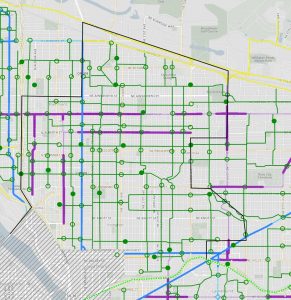
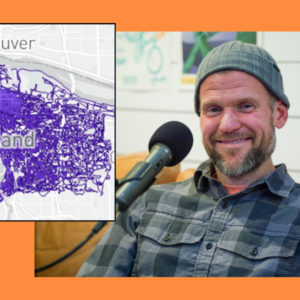
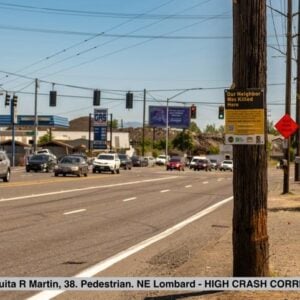
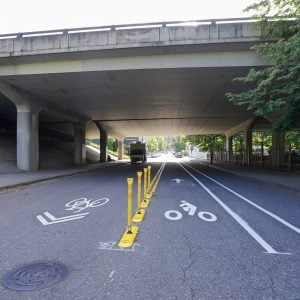
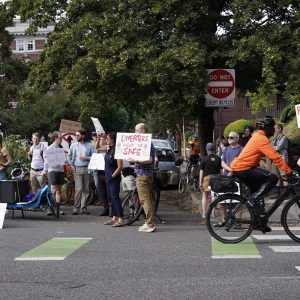
Thanks for reading.
BikePortland has served this community with independent community journalism since 2005. We rely on subscriptions from readers like you to survive. Your financial support is vital in keeping this valuable resource alive and well.
Please subscribe today to strengthen and expand our work.
This doesn’t appear to be the entire map, is their a link to see the whole thing?
I believe he only prepared this for inner northeast, as part of a presentation targeted to the area.
SE Uplift and North Portland are in production……maybe by end oif next week.
There’s an unfortunate bug/issue in Google Maps where it can’t tell between car turn restrictions and bike exceptions. Routes with diverters end up having bikes directed away from bike-friendly routes in Google Maps. This issue needs more attention because they seem to think it’s not particularly important. With diverters becoming more common it’s a serious problem for their bicycle directions. If anyone notices a bike route on Google that gets directed away by a diverter, please submit feedback and mention this issue. You can also vote up the issue in their product forum.
https://productforums.google.com/forum/?utm_medium=email&utm_source=footer#!topic/map-maker/ufeGrFAh-l0
It might be worthwhile adding such gaps as a “pedestrian underpass” in google mapmaker. I haven’t tried it, but it’s the best bet I know of to improve the routing.
https://www.google.com/mapmaker
Well, I tried. Ended up with “There is something wrong with this feature. Please report this error with a link to this page” errors I could not resolve.
The “pedestrian underpass” approach is what I’ve been trying too, but so far the underpass is always “disconnected from any existing network”. I’m trying to work with our local Greenways group to get a contact at Google to raise the visibility of this issue and/or get a workaround.
I would love this SO MUCH. A few weeks ago I walked up Clinton from the Tilikum Bridge to about 45th. I was in a great mood and the whole walk reminded me of Portland 20 years ago when I first moved here. It was the diverters, taking away the constant car noise and inviting everyone else out to breathe and conduct their lives. I want this for our city.
When I walk or run in the city, I typically pick my routes to coincide with greenways, as the crossings are typically better, and the traffic levels are lower. These corridors benefit all users!
Thanks, I’m glad you like it! It will need much community support to get it passed as policy, but one has to start somewhere.
The powers that be know I am working on this.
What happened to Ainsworth. It has been a major bike freeway since the mid 50’s and was still a couple of years ago from Willamette boulevard to NE 52nd?
Like Knott, Ainsworth carries a lot oif traffic, too much for a local service Street. I did not highlight them because we would need to find creative Sollutions. Im all in favor of Ainsworth brimng turned into a huge bike focussed linear park.
I am imagining a good trial being Reed Colleges Place by Divertering in each direction at Knapp and Tolman, if needed Glenwood. That would make for a safe linear park Greenway without bus conflicts like on SE 32 nd. It may be a tough sell to locals, but I am very willing to try. Maybe for a summer to see how comfortable it is?
Then if it works, move to NE 72 nd and then Ainsworth.
A good solution for Ainsworth, considered at a couple crossings, is to close off the through street connection except for pedestrians and cyclists, and construct mid-block U-turn sections. So, like those higher speed Michigan left configurations, anyone in a car that wants to go left would first have to go right to a U-turn location. This would remove the auto turn movements from the crossing location prioritized for pedestrians and cyclists.
I like that idea. Im Thinking about that on Reed College Place now….do you happen have a good slide that you could post?
I’ve never had occasion to ride streets officially designated neighborhood greenways, set up with physical barriers to divert people operating motor vehicles, away from using said streets.
Cut-through use of neighborhood streets by people not living in a particular neighborhood they’re using for that purpose, can be one of the worst plagues that can beset a neighborhood. On that count, diverters used with neighborhood greenways could be a positive aid to preserving neighborhood livability. I have to wonder though, whenever the idea of diverters with greenways streets is proposed, whether consideration for neighbors ability to get to their residence by car if need be, within greenway-diverter designated areas, has been fully considered.
Also to consider, is whether some streets designated as neighborhood greenways, by virtue of potentially high numbers of people choosing to use them, can continue to be the “…low-traffic, low-stress side streets…” said to be the characteristics that define what a neighborhood greenway is. If there were to be a rising of number of people riding bikes, not from the neighborhood, using streets so designated, that could cause the ‘low traffic, low stress’ quality of the street to be affected.
Eventually for some quiet neighborhood streets designated as neighborhood greenways, the question of ‘how much bike traffic is too much?’, may rise.
We need to stop looking at Greenways as corridors and start working towards neighborhood-wide calming using filtered permeability. We need to train drivers that rat-running through neighborhoods is not okay, bike route or not.
Can you elaborate more on “filtered permeability”? I’m not familiar with the term.
slide 30 and 31:
https://www.portlandoregon.gov/transportation/article/267721
Utrecht, Netherlands.
https://en.wikipedia.org/wiki/Utrecht
Fascinating. Thanks for this.
With the number of people being guided by Google Maps to cut through side streets, I wonder if we could avoid aggressive cut-throughs simply by convincing Google Maps that a diverter exists.
Google Maps? Or more likely apps like Waze?
It is also used in Vancouver, BC, just west of its downtown, near Stanley Park.
Why not just have Maxwell’s daemon stand at intersections and direct bikes one way and cars another?
YES YES YES.
In addition to diversion, we need full, hawk, or half signals at all Greenway-collector intersections.
Absolutely. Diversion is important to keep volumes down, but the crossings at major intersections are the real weak links in the system.
Signals are expensive. $250,000 for a full signal set; $125,000 for HAWK; $80,000 or so for a PBOT set of rapid-flashing-beacons. It adds up pretty quickly.
Is this proposing diverters *on* the collector/arterial streets or am I missing something?
The intent, as I understand it, is to automatically do diversion at every major crossing, similar to Chavez/Clinton, Holman/33rd, Going/33rd, etc., regardless of whether or not the greenway has a current volume problem – ‘problem’ being auto volumes above some number. PBOT has a goal of 1,000 autos per day on greenways, with treatment generally required for volumes over 1,500.
whether or not the greenway has a current volume problem
When you create a greenway, it makes the rotate more favorable to drivers because now all the stop signs are flipped. Whatever current lack of volume problem will soon turn into a volume problem without diversion. The idea is that we want to stop the problem from occurring proactively.
Attaching an “except bicycles” to the stop signs would fix that.
Also, to avoid the speed demons from turning ONTO the Greenway and hitting someone head on. These streets are narrow generally, and all it takes is one or two startling experiences to stop a beginner from riding.
But what do I know, I have only been talking to the ” interested but concerned” about Greenways and Diversion since the Adam’s administration built NE Going…..which has a diverter of some sort at every corridor or collector from Williams to 33 Rd.
They all seem to say the same thing……the diverters are what make the Greenway function, both physically and Psychologically.
That is what ” Mary and Jane ” about the 20 s Bikeway in part is trying to show.
How about locating “white bike” memorials at all diverters, including a really wrecked bike, to caution users?
Why not have the diverters in the middle of the neighborhood so you don’t get the ‘gated’ feeling? Put up a sign that says “Not a through street”. People may go down the rabbit hole once but they will learn. Also, one structure will turn m.v. traffic on two crossing streets.
The concern there is that you’re then shifting a lot of traffic onto a randomly-selected neighborhood street that’s not built to support it. And it becomes a fight as to which such neighborhood street becomes the sacrificial lamb. Better to keep traffic on arterial streets where possible.
This is especially true in SW & East Portland, where local streets do not connect very well, and even local trips require the use of major arterial roadways.
This Policy would only apply to the inner pattern areas where there is a street grid, it even excludes Cully and Darlington. As my whole proposal argues, in East Portland there is already built in Diversion as we have to cut through parks and cul-de-sac’s to make NEW bike bike connections, in SW the Greenways dip from hills onto cyle-tracked main streets like SW Multnomah.
It is a fairly developed proposal, not just a map. I can E-mail you the PDF when I get a chance.
In some cases, that would work fine. Flexibility is important, but for the main commuter high crash corridors, the fewer number of turning points helps out all involved.
If the diverters are mid-block, you would have the problem of frustrated motorists making dangerous U-turns. No thanks.
You could add “no outlet” or “dead end” signage. East Portland has one of these on 129th between Powell & Division, part of the 130s greenway. It works quite well.
“no outlet” and “dead end” signage is often missing the “except bikes” part. I can’t tell you how many times those signs have thrown off my wayfinding. Now if I see a sign that says “dead end” I keep going, but it took a few years to get the hang of it.
Given the phenomenon of google maps guiding people to cut-throughs. Maybe it would be cheaper to just pay google( useing new gas tax revenues) to put in virtual diverters in desired spots so that the map algorythem would no longer guide people to cut through neighborhoods.
However, apps like WAZE depend on user supplied information – real eyes driving the street.
Well, beat them at their own game.
Ride your bike with WAZE running. If enough bicycle riders did so the app would show traffic as backed up because of the slow speed and divert the auto traffic elsewhere.
Also useful at rush-hour with bike lanes bypassing the stopped traffic — adds more to the pile.
The vision looks similar to what Utrecht and Houten have done.
Utrecht
https://bicycledutch.wordpress.com/2013/08/08/making-a-1960s-street-grid-fit-for-the-21st-century/
Houten
http://eurobikegeek.blogspot.com/2011_07_01_archive.html
I would cry tears of joy and relief if such a plan were ever realized such as that in the proposed map. Few things would surpass the enthusiasm that I have for this city as the modifications found within this project.
It would require a great horde of daemons to do so at every required intersection…then AAA would contract for exorcists.
Here in Vancouver BC I won’t say that ALL Greenway/Major Street intersections have diverters, but I think that most do. Also diverters on local streets where doing so will block ‘rat running’ by drivers. Also fairly common traffic-calming of various sorts on Bike Routes and Greenways.
And more of all of this coming in the next year or two.
Not perfect, but good and getting better and better.
I did not include Knott or Ainsworth that are designated at local service streets, but act like collectors, because the volumes are high eoungh that either we need to move to fully seperated facilities or come up with more creative solutions.
I also did not include bike lane facilities on major corridors so as not to make the map so messy.
To be clear, the Greenway Report tools of peak direction volumes,speeds and total volumes work in the neighborhood interiors or in the outer pattern areas without a complete grid. The policy I am working on would apply only to the inner pattern areas with a street grid. Each diverter would be allowed a large amount of flexibility depending on local needs.. But the main streets become much more predictable to commuters as well as the Greenway, as one knows not to turn on them from the corridor, or when you approach one on a bike you know that aggressive truck can not follow you. At least legally.
My full proposal is working its way through a neighborhood near you! If you are on a Neighborhood Board between the River and Approximately I 205, I am prepared to give a tailored presentation to you area for endorsement.
Greenway Design standards as a replacement for Level of Service.
For context, in NE Coalition we have 15 current built diverters, 6 by default as are new connections through dead ends or parks, and 79 more by policy for a total of 100. Then PBOT would only have to monitor the areas inside in the neighborhood grid, instead of 40% of our entire Bikeway system as we grow.
Thank you Michael for the great, surprise, write up! I have not checked BikePortland’s site all day as I am getting ready for my weekend plans.
I always like nice surprises. Oh, and thank you PBOT and the comprehensive plan for the base map.
I once drove from downtown portland along side streets to 205 in a van. I drove slow and courteous. Even traversed tabor. It was no big deal. Why? Because I drove slow and courteous. One could easily map the stop signs and find a way through with miniMal stops. People just want to drive fast. That’s the main issue.
I live way out SE. If I’m headed west, and I’m not in a hurry, and have to drive for whatever reason, I’ll confess that I often take the bikeways. I can get from 139th to 39th without diversion, and if I’m honest I’d be a little sad if it was installed. Mainly because driving bikeways puts me in a more bikey mood, which is way better than a SE Division mood! That said, it’s a minor selfish reason and I’m still in favor of more diversion overall.
Judging from all the cars I’ve seen on Lincoln/Harrison and on Ankeny with USCF, NORBA, or BTA stickers, my guess is that you are part of a not-inconsiderable minority of cyclists who drive only on bike routes, when given half a chance. The TDM diverters are way overdue, precisely because of the large and growing number of drivers like yourself.
take the main roads when driving
Nice work, Terry!
Ted
Thanks Ted! I am prepared to present at the next BikeLoudPDX monthly met. My map from the river east just past I205 is nearly complete, and should be ready for a high level global presentatation about how the policy would work.
I’d like to call out Terry for being an absolute Portland gem! As someone who bikes pretty regularly, I feel so lucky to have him advocating for me. Great job and keep fighting the good fight!
Thank you!
Do this. Yesterday. Whether or not the traffic counts are above 3000 vpd, or whatever the current threshold is.
Sorry, 1500 vpd.
Really interesting ideas, here!
Terry, what’s the solid green circle at N Morris and Vancouver, in between Dawson Park and the hospital? Vancouver is one way there, going south, but cars driving south on Vancouver can turn left onto Morris.
Also, there’s a diverter missing: On NE Cook at Williams, on the east side of the intersection (which is now signaled), there’s a diverter that keeps you from exiting or entering the neighborhood there. That forces drivers coming off the Fremont Bridge to turn right onto Vancouver or turn left onto Williams rather than being able to go straight into the neighborhood there.
Also, do the MLK diverters let people out of neighborhoods? At some of the MLK spots, the traffic light on the greenway is the only way to exit the neighborhood (because MLK is so busy) in a car.
They are abstract in the extreme, some diverters are just half only allowing exit, some only prevent Street crossings, others are by default because the route turns into a path or bike lane. That Morris circle is confusing I see, but good catch on Williams and Cook. There may be a few others I have missed city wide, but I tried to catch them all. Thanks